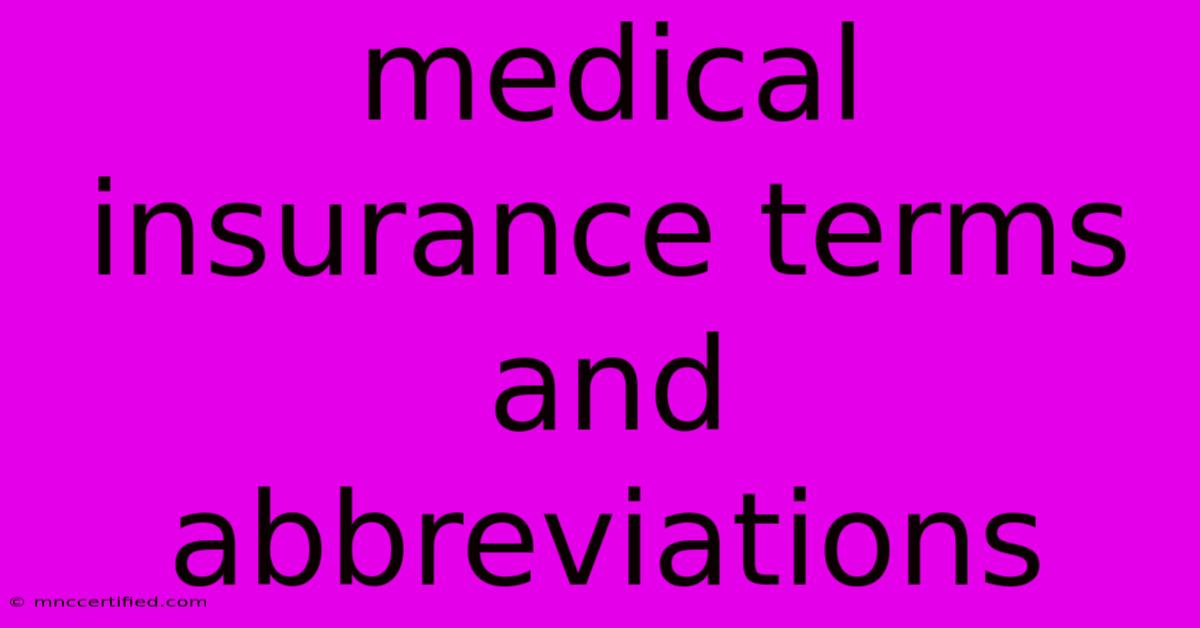Medical Insurance Terms And Abbreviations

Table of Contents
Decoding the Jargon: A Guide to Common Medical Insurance Terms and Abbreviations
Navigating the world of medical insurance can feel like deciphering a foreign language. With its unique terminology and acronyms, understanding your coverage and billing can be a daunting task. This guide breaks down common medical insurance terms and abbreviations, empowering you to become a savvy healthcare consumer.
Essential Terms You Should Know:
1. Premium: The monthly payment you make to your insurance company for coverage.
2. Deductible: The amount you pay out-of-pocket before your insurance coverage kicks in.
3. Co-pay: A fixed amount you pay for each medical service, like a doctor's visit or prescription.
4. Co-insurance: A percentage of the medical bill you pay after your deductible is met.
5. Out-of-pocket maximum: The maximum amount you'll pay for covered medical expenses in a year.
6. Coverage: The range of medical services your insurance plan covers.
7. Network: A group of doctors, hospitals, and other healthcare providers who have agreed to provide services at negotiated rates for your insurance plan.
8. Pre-existing condition: A health condition you had before you enrolled in your insurance plan.
9. Claims: Requests for reimbursement for medical expenses.
10. Beneficiary: The person who receives benefits from the insurance policy.
Common Abbreviations You'll Encounter:
1. HMO (Health Maintenance Organization): A type of health insurance plan that typically provides coverage through a network of doctors and hospitals.
2. PPO (Preferred Provider Organization): Offers greater flexibility in choosing doctors and hospitals, but may have higher premiums.
3. EPO (Exclusive Provider Organization): Similar to an HMO but generally offers a wider network of providers.
4. POS (Point of Service): Combines features of HMOs and PPOs, offering greater flexibility but potentially higher costs.
5. PCP (Primary Care Physician): Your main point of contact for healthcare needs.
6. EOB (Explanation of Benefits): A document detailing the charges incurred for a medical service and how your insurance plan covered them.
7. TPA (Third-Party Administrator): A company that administers insurance plans on behalf of employers or other organizations.
8. HIPAA (Health Insurance Portability and Accountability Act): A federal law that protects the privacy of your health information.
9. CMS (Centers for Medicare and Medicaid Services): The federal agency that administers Medicare and Medicaid.
10. ICD-10 (International Classification of Diseases, 10th Revision): A system used to classify diseases and medical conditions.
Why Understanding These Terms Matters:
- Informed Decision Making: Knowing the terminology empowers you to choose a plan that meets your needs and budget.
- Cost Control: Understanding your coverage and financial responsibilities helps you manage healthcare expenses.
- Effective Communication: Clear communication with insurance providers and healthcare professionals is vital.
Tips for Navigating Medical Insurance:
- Read your policy carefully: Take the time to understand your coverage and limitations.
- Ask questions: Don't hesitate to contact your insurance provider for clarification.
- Keep track of your claims: Review your EOBs and ensure your bills are handled correctly.
- Stay informed: Regularly review your insurance policy and research changes in coverage.
By becoming familiar with these essential terms and abbreviations, you can navigate the world of medical insurance with greater confidence and make informed decisions about your healthcare.

Thank you for visiting our website wich cover about Medical Insurance Terms And Abbreviations. We hope the information provided has been useful to you. Feel free to contact us if you have any questions or need further assistance. See you next time and dont miss to bookmark.
Featured Posts
-
Malpractice Insurance Occupational Therapy
Nov 07, 2024
-
Forex Trading Website Script Free Download
Nov 07, 2024
-
Aaa Life Insurance Beneficiary Change Form
Nov 07, 2024
-
Cubarsi Announces E30 M Deco Transfer Fee
Nov 07, 2024
-
Naomi Biden Sets Election Day Date
Nov 07, 2024